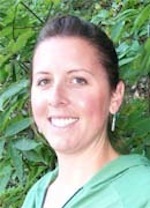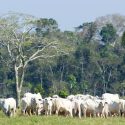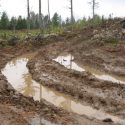Study challenges prevailing view of invasive species
Eurasian water milfoil, the light green plants seen in the lower center of this image, growing alongside native plants in a Wisconsin lake.
Photo: Frank J. Koshere
Zebra mussels. Asian carp. Kudzu. Chances are you recognize these names as belonging to invasive species — plants or animals that are relocated from their native habitat to a foreign land, only to prove so prolific that they take over their new home. Except that’s not how the story usually goes, according to a new study.
The study, out of the Center for Limnology at UW–Madison, says overabundance is not the most common plot in invasive species stories. In fact, the species we consider to be invasive usually exist in low numbers, quietly occupying a niche at densities so low, you might not even notice they are there. The study was published online in the journal PLOS ONE on Oct. 23.
“Invasive species are often thought of as species that take over wherever they get in,” says Jake Vander Zanden, a UW limnology professor who directed the research. “But, in our experience studying lakes and rivers, in most places they weren’t all that abundant. It was only in a few places where they got out of hand.”
Jake Vander Zanden
If that pattern held true, the researchers realized, then invasives were acting a lot like their native counterparts.
To test these observations, Vander Zanden and 13 researchers collaborated to compile data on 17 invasive and 104 native aquatic species, comprising a total of 24,000 abundance measurements. Their analysis revealed that, by and large, invasive and native species followed similar distribution patterns, suggesting that they play by the same ecological rules.
“Pick a species, any species, and you’ll find that high abundance is the exception, not the rule,” says Gretchen Hansen, who was the study’s lead author as a postdoctoral researcher at the UW and is now a research scientist with the Wisconsin Department of Natural Resources.
“If you sample a large number of locations like lakes, fields or patches of forest, you will only find a few individuals of your chosen species in most locations. It will be rare most of the time,” Hansen says. “Every now and then though, you will find a place where conditions are just right and the sample will be chock full of the plant or animal in question. This holds true for both natives and what are often called ‘invasives.'”

Gretchen Hansen
There are, however, differences. Invasives are, on average, three times more abundant than natives. But that is still a small number. Take crayfish, for example. Set out one hundred traps in a lake and you can expect to catch six native crayfish in a day, Hansen says. That same time frame will net you nineteen invasives. While that’s triple the native catch, it’s not exactly a huge number, she says. Whether this difference leads to measurable negative impacts is unknown.
“We’re not saying invasive species aren’t a problem,” says Hansen, “but this paper points to several important questions for which we don’t currently have answers.”
Answering these questions is important for a number of reasons. In Wisconsin, for example, research has shown that lakefront property owners see the value of their property plummet if it’s discovered that an invasive aquatic plant, Eurasian water milfoil, is in their lake. But, says Vander Zanden, that’s “only a reaction to the presence of the plant, not a reflection of its impact on that specific lake.”
“We’re not saying invasive species aren’t a problem, but this paper points to several important questions for which we don’t currently have answers.”
Gretchen Hansen
Perhaps more importantly, he argues, if scientists can identify characteristics of the sites where a specific invasive species will flourish or determine what level of abundance constitutes an “invasion,” then the countless hours and millions of dollars spent on invasive species control each year could be better allocated.
It’s time and money, says Vander Zanden, that’s currently spent in a “scattershot” manner. “We need to get better at fighting invasive species and focusing our efforts at prevention and control,” he says.
One way to do that would be to identify invasive species “hotspots.” For example, in human disease epidemics, it is accepted practice for health professionals to target “hotspots” where outbreaks or the transmission of disease is most likely to occur. Focusing efforts on these specific areas is crucial to containing the problem, Vander Zanden says.
That would be a good approach to the invasive issue, too, says Hansen. “Of all the species we know to be invasive, our study shows that they are likely to reach high densities in only a few places — predicting which ones would help focus control efforts on the sites where they’re likely to become highly abundant, letting us spend our limited resources in ways that will provide the maximum benefit.”
—Adam Hinterthuer
Tags: biosciences, environment, limnology, research, water



